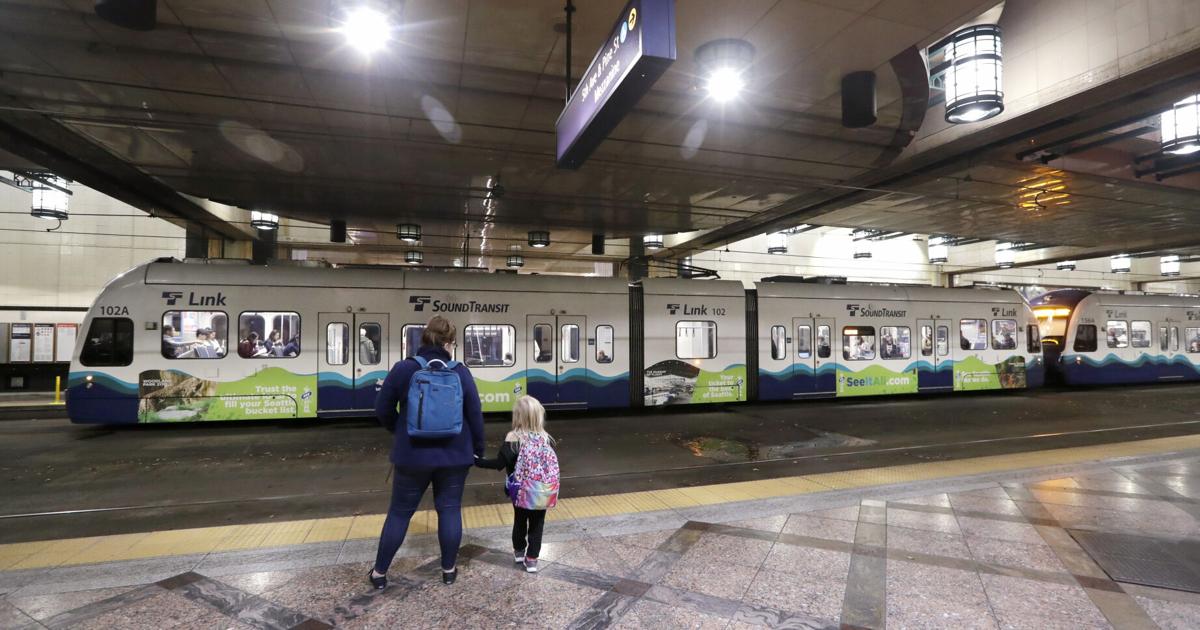By Mike Lindblom
Copyright stltoday

Mike Lindblom | The Seattle Times
SEATTLE — A desperate long-term financial forecast has provoked Seattle’s Sound Transit to explore installing fare gates at light rail stations, a notion previously considered unworkable.
Later this year, CEO Dow Constantine will propose a pilot project to place fare gates within various key stations,” and to consider policies to build gates at all future stations, he told a transit board committee last week. No timeline exists yet to do so.
That follows the agency’s revelation in late August that long-term costs could rise $35 billion more, pushing the 2017-46 spending plan near $185 billion.
A tougher fare collection program would make only a small dent. An equally potent factor is public frustration with fare dodgers. Sound Transit might lose political support if taxpayers continue to feel like chumps because there’s minimal enforcement.
“I’m very serious about it,” transit board Chair Dave Somers, the Snohomish County executive, said in an interview.
“Our performance is atrocious in terms of fare recovery,” Somers said. “It’s really not fair, because we’re asking car-tab payers to pay (for transit), and the riders should be paying their fair share also.” Car-tab evasion itself is widespread and considered unmeasurable by the state government.
This year’s budget assumes fare income of $42.4 million, about 10% of the $430 million used to operate existing light rail lines. Actual fare payments are ahead $2 million, because ridership has grown past 100,000 daily boardings.
In its early years, Sound Transit promised voters that fares would pay 40% of train operating expenses, and basically reached that level for a couple of years, after the University of Washington and Capitol Hill stations opened in late 2016. The target has since been reduced by half. Longer rail lines into less-dense communities mean less revenue per mile, while labor and supply costs rise. To broaden access, politicians created free youth fares, and discount $1 fares for low-income ORCA Lift pass holders.
If you include capital expenses to build tracks, stations, trains, and buses, Sound Transit fares are forecast to cover only 1.4% of this year’s $4.4 billion overall budget, and 4% long term, revised downward from 7% a few years ago.
Auburn Mayor Nancy Backus, who chairs the transit board’s finance committee, said she’s glad to see fare gates being explored, because Sound Transit should be held accountable to collect money it told voters would be collected, and “make sure we’re doing what we can.”
Sound Transit has relied on a modified honor system for paying fares, like light rail in Portland, Dallas, Denver, Minneapolis and Calgary, Alberta, since service began in 2009 from downtown Seattle to Tukwila. Instead of passing through turnstiles, riders are canvassed aboard the trains by inspectors who ask to see their ticket or ORCA card.
In the 2010s, well over 90% of riders paid, and one-tenth of railcars underwent fare sweeps, agency reports said. In the early 2020s, payers fell to roughly 55%, as enforcement all but disappeared, and youth rides became free. Sound Transit assumes that in the long run, 75% of passengers will pay.
In recent months, a team of 35 fare ambassadors checked a mere 3% of railcars, and 89% of riders they approached showed proof of payment.
Somers is skeptical. When he takes a train to sporting events in Sodo, “the vast majority of people” do not tap their ORCA cards at the yellow readers, he said. Fare ambassadors can’t efficiently check everyone on a crowded train, or cover all hours.
Brian de Place, acting director of security and fare enforcement, speculated during a July committee session that fare gates could boost compliance to “in the mid-90s, or even high 90(s) percent,” when asked by transit board member Girmay Zahilay of South Seattle.
None of Sound Transit’s 33 stations have fare gates, and six more will open within a year. They would need retrofits.
Many have narrow floor plans where gates might not fit easily, with some exceptions like Tukwila International Boulevard, Westlake, Symphony, Northgate and Bellevue Downtown.
One advantage is Sound Transit’s flat $3 fare, so gates are needed only at entrances, not exits. Systems that charge fares based on distance or time of day, for instance, need gates for people exiting to verify someone paid the correct fare.
Retrofitting stations can be a tough sell.
Edmonton, in Alberta, considered a two-year tryout at two stations, mainly as a security tool, but canceled it because of a $7.2 million expense, including attendants to help people without fare cards.
Minneapolis talked about a turnstile tryout at four stations, but decided not to spend $14 million. Another objection should sound familiar in Seattle: that people would evade gates by walking on tracks at surface stations.
On the other hand, Bay Area Rapid Transit (BART), which operates mainly on fares from 50 stations, is installing taller, stronger gates, which Sound Transit executives toured during a convention this summer.
St. Louis is adding huge steel gates to 38 stations for $52 million, mainly to enhance security.
Sound Transit’s interest appears more real than in the early 2020s, when a few board members asked informally about fare gates. A draft report in October 2022, which the board didn’t examine in depth, estimated $104 million to retrofit 19 stations in Seattle and six in Tacoma. Actual costs would be higher, to install wires underground and through station floors.
The biggest revelation was that gates could be added to a few of the busiest stations and pay for themselves within seven years, a strategy used in Los Angeles.
However, Somers said he’s not keen on partial gating, and believes all-or-none is better.
SkyTrain in Vancouver, B.C., added chest-high gates to all 53 stations in the 2010s for $195 million. Those boosted revenues an estimated $30 million in just the first eight months. Fare evasion at gated SkyTrain stations is currently 3%, compared with 10% on buses, the transit agency reported.
Board member Claudia Balducci of Bellevue, who is vying with Zahilay this fall to be elected King County executive, said she’s mainly curious about the bottom line.
“I do think that there are probably some locations where it would make a lot of sense to have fare gates,” said Balducci, who chairs Sound Transit’s expansion committee. “But we did a costing of what it would take to retrofit the entire system with fare gates a few years ago. And it was very expensive.
So are fare ambassadors. That program is expected to require $672 million through 2046, but they create goodwill by helping travelers, and by reporting safety hazards or emergencies. If gates are ever built, Somers predicts the ambassador ranks will thin.



